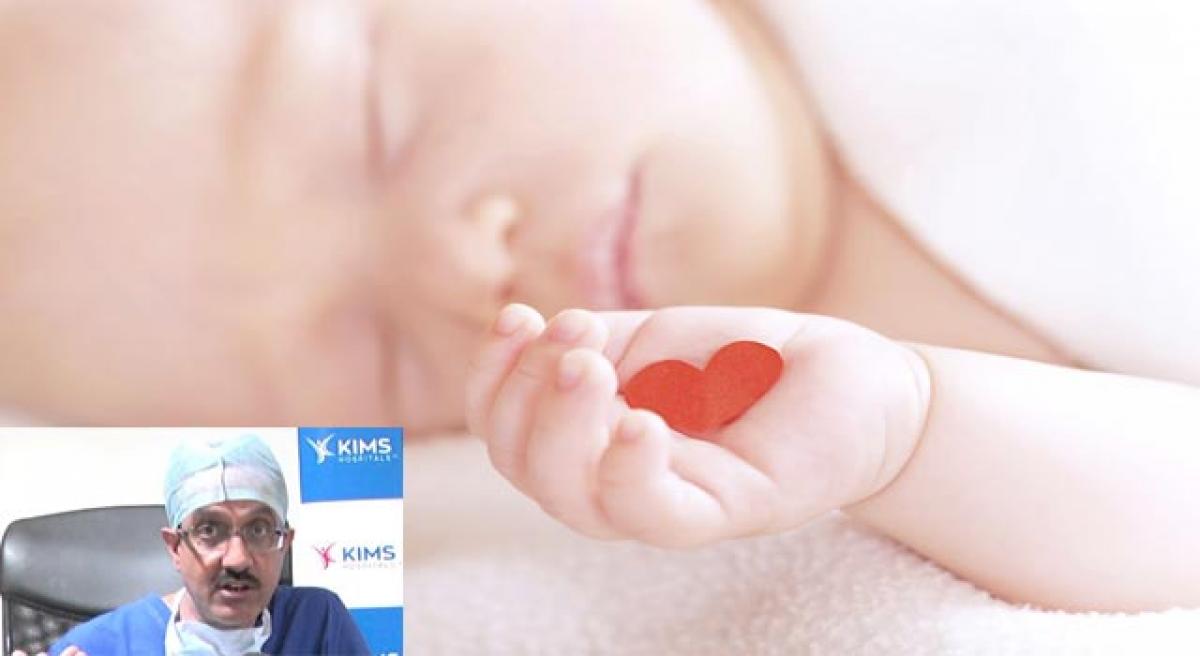Live
- Kareena reveals her favourite Shyam Benegal film featuring sister Karisma
- A day with Collector Jeebanananda Mohanty
- Odisha signs pact to operate hydrogen-powered bus
- I am a victim of chit fund scam too: Majhi
- Telangana’s Ganapathi Self-Help Group Emerges Winner at PepsiCo India’s RevolutioNari Awards 2024
- Karnataka State real estate body faces problems over fine collection from builders
- ‘Mother India’ Shefali Shah goes river rafting in Rishikesh
- Hotlines meant for cybercrimes not going through in Bengaluru
- Police appeals to public to stay alert against ‘digital arrest’ scam
- Coastal enthusiasts rejoice as govt announces funding for Kambala
Just In

Quick detection of heart defects in newborn babies after birth and appropriate treatment can be lifesaving. If the cardiac defect is completely corrected, the babies can have normal growth and development and can lead a normal life like other children.
Quick detection of heart defects in newborn babies after birth and appropriate treatment can be lifesaving. If the cardiac defect is completely corrected, the babies can have normal growth and development and can lead a normal life like other children.
There are many types of cardiac defects and some of them are very complex. Babies born with these defects show symptoms and signs soon after birth that prompt detection of the lesions; usually they present with difficulty in taking feeds (respiratory distress) and poor oxygen saturation (blue baby). Among the complex lesions, transposition of great arteries (TGA) is a very common defect that is seen in these babies.
In this defect, the two great arteries which come out of the heart are in the reverse position. In other words, the aorta which takes pure blood to the entire body originates from the right side ventricle instead of the left and the pulmonary artery which takes impure blood to the lungs originates from the left side ventricle instead of the right. Because of this, the baby is blue in view of low oxygen saturation.
In many instances there is an associated defect in the ventricular septum between the left and right ventricles (ventricular septal defect- VSD) and this changes the management plan of the problem. In other words, if there is no VSD the surgical treatment should be done urgently before the left ventricle becomes weak; if there is a VSD the surgery can be done at one month age.
The name of the surgery for TGA is called Arterial Switch Operation. This means the great arteries have to be switched to the appropriate ventricles. This is the most complex heart surgery that is done in the new born. The complexity is because of the transfer of the coronary arteries (arteries which take blood to the heart from the aorta) along with the aorta and this is a very difficult surgical step that involves skill and experience.
To add to the complexity, the anatomy of the coronary arteries in this setting is many times not normal and sometimes there may be a single coronary artery. Surgical strategies have to be modified appropriately to handle these abnormalities. In addition, closing the VSD in a new born with TGA is a surgical challenge and needs careful handling of the delicate muscle of the ventricle with fine sutures.
In KIMS Hospitals we have done 92 arterial switch operations in the last four years till date; among them, 60 babies had an associated VSD and 75 per cent of these cases the coronary arteries were abnormal. Majority of the babies were less than 3 kg in weight and the smallest baby we operated was 2 kg. After a major surgery which lasts for many hours the babies require delicate and skillful care in the postoperative period that involves a major team of doctors and nurses in a sophisticated and well equipped Intensive Care Unit.
The surgical outcomes have been excellent. The most gratifying thing to the team of doctors is to see the babies with the mothers doing very well during follow up, gaining good weight with normal feeding, growth and development.
Case study of Ramsri Anil :
Master Ramsri Anil is 2 years and 10 months old today. He was born in November 2013 in Vijayawada and was detected to have complex congenital heart disease with transposition of great arteries (TGA) when he was admitted to a local hospital there due to breathing difficulty and very low oxygen saturations and had to be put on the ventilator (breathing machine). He was shifted to KIMS Hospitals in ambulance with medical team support on the 15th day of life.
After stabilization, he was operated in November 2013 for arterial switch operation. He did well postoperatively and recovered and went home. Recently, on the Krishnastami daythe family celebrated the event by dressing him like Lord Krishna and sent us the photographs of the boy happily spending the event with the family.
Author is Senior Consultant Paediatric Cardiac Surgeon, KIMS Hospitals.
By Dr D Anil Kumar

© 2024 Hyderabad Media House Limited/The Hans India. All rights reserved. Powered by hocalwire.com







